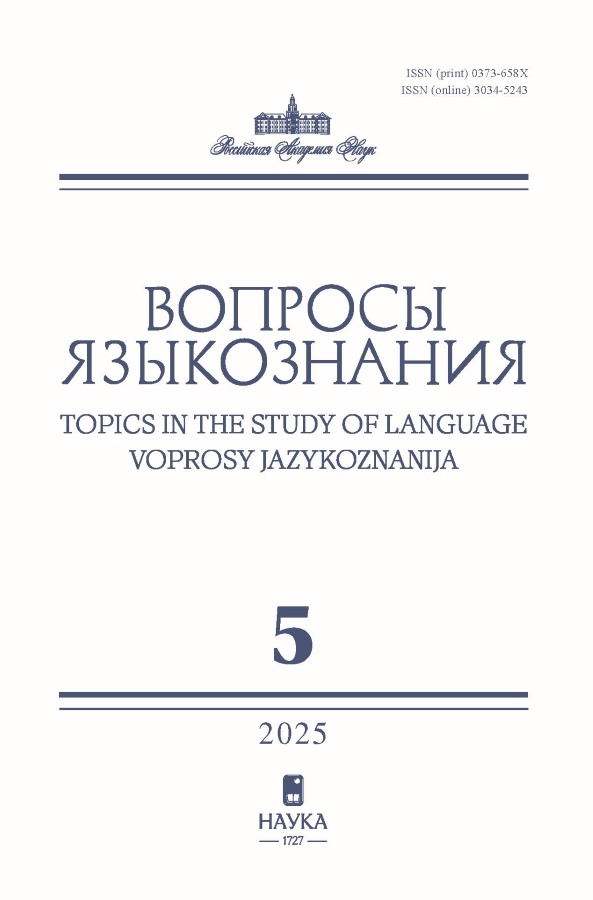Interaction of locative adverbials with the meaning of the predicate
- Authors: Boguslavsky I.M1,2
-
Affiliations:
- Kharkevich Institute for Information Transmission Problems, Russian Academy of Sciences
- Universidad Politécnica de Madrid
- Issue: No 5 (2025)
- Pages: 44-60
- Section: Special issue in memory of Leonid L. Iomdin
- URL: https://rjdentistry.com/0373-658X/article/view/691096
- DOI: https://doi.org/10.31857/0373-658X.2025.4.44-60
- ID: 691096
Cite item
Abstract
A whole series of locative adverbials group around the concept of distance between two points, for example, na tri kilometra (≈ ‘by three kilometers’ or ‘three kilometers away/further’), v trёh kilometrah (≈ ‘at the point three kilometers away’), za tri kilometra ( ‘three kilometers away from here’), na rasstojanii (protjaženii) trёh kilometrov (≈ ‘at a distance of three kilometers’), na pušečnyj vystrel (≈ ‘at a cannon shot’), na bezopasnoe rasstojanie ( ‘to a safe distance’), blizko ( ‘close’), vblizi ( ‘close by’), vplotnuju ( ‘next to’), daleko ( ‘far’), vdaleke ( ≈ ‘far off’), etc. Although the value of this distance is typically quite transparent, the points delimiting it are often left implicit. We study some types of sentences in which the identification of these points is non-obvious or even ambiguous. Depending on the choice of these points, two types of adverbial interpretation should be distinguished—source-oriented and goal-oriented interpretations. The factors shaping each interpretation depend on both the verb’s meaning and the adverbial’s nature. Several specific adverbials demonstrating unusual properties are described. The adverbial na pušečnyj vystrel ( ‘at a cannon-shot distance’) has opposite meanings in a number of uses. The adverbial na bezopasnoe rasstojanie ( ‘to a safe distance’) behaves differently with goal-oriented and source-oriented verbs: in the first case, it falls within the scope of the inchoative seme present in the verb’s meaning, while in the second case it lacks this capacity. Finally, it is shown that the expression bolee čem N ( ‘more than N’) has three types of interpretation in combination with goal-oriented verbs, in one of which it is paradoxically synonymous with the expression menee čem N ( ‘less than N’).
Keywords
About the authors
I. M Boguslavsky
Kharkevich Institute for Information Transmission Problems, Russian Academy of Sciences; Universidad Politécnica de Madrid
Email: igor.m.boguslavsky@gmail.com
Moscow, Russia; Madrid, Spain
References
- Apresjan V. Yu., Shmelev A. D. Asymmetry of ‘far’ and ‘close’: Temporal meanings. Russian Linguistics, 2020, 3(44): 203–230.
- Boguslavsky I. M. Scope of inchoativity and communicative structure: Attraction of the rheme. Semiotika i informatika, 1998, 36: 8–18.
- Glovinskaya M. Ya. Semanticheskie tipy vidovykh protivopostavlenii russkogo glagola
- Zalizniak Anna A. Zasvetlo or zatemno? On the question of enantiosemy in semantic derivation. Issledovaniya po russkoi i komparativnoi semantike. Zalizniak Anna A., Shmelev A. D. Moscow: Yazyki slavyanskoi kul’tury, 2021, 329–345.
- Russian National Corpus. http://www.ruscorpora.ru.
- Shmelev A. D. Cognitive and communicative origins of enantiosemy. Issledovaniya po russkoi i komparativnoi semantike. Zalizniak Anna A., Shmelev A. D. Moscow: Yazyki slavyanskoi kul’tury, 2021, 290–328.
- Bourdin 1997 — Bourdin P. On goal-bias across languages: Modal, configurational and orientational parameters. Proceedings of LP’96. Typology: Prototypes, item orderings and universals. Palek B., Fujimura O., Neustupný J. V. (ed.). Praha: Charles Univ. Press, 1997, 185–218.
- Fagard, Kopecka 2021 — Fagard B., Kopecka A. Source / Goal (a)symmetry. A comparative study of German and Polish. Studies in Language, 2021, 1(45): 130–171.
- Georgakopoulos 2018 — Georgakopoulos T. A frame-based approach to the source-goal asymmetry: Synchronic and diachronic evidence from Ancient Greek. Constructions and Frames, 2018, 10(1): 61–97.
- Ikegami 1979 — Ikegami Y. ‘Goal’ over ‘source’: A case of linguistic dissymmetry. Hungarian Studies in English, 1979, 12: 139–157.
- Ikegami 1987 — Ikegami Y. ‘Source’ vs. ‘Goal’: A case of linguistic dissymmetry. Concept of case. Dirven R., Radden G. (eds.). Tübingen: Günter Narr, 1987, 122–146.
- Lakusta, Landau 2005 — Lakusta L., Landau B. Starting at the end: The importance of goals in spatial language. Cognition, 2005, 96(1): 1–33.
- Shmelev 2016 — Shmelev A. Semantic shifts as source of enantiosemy. The lexical typology of semantic shifts. Juvonen P, Koptjevskaja-Tamm M. (eds.). Berlin; Boston: Walter de Gruyter, 2016, 67–95.
- Stefanowitsch 2018 — Stefanowitsch A. The goal bias revisited: A collostructional approach. Yearbook of the German Cognitive Linguistics Association, 2018, 6(1): 143–166.
- Stefanowitsch, Rohde 2004 — Stefanowitsch A., Rohde A. The goal bias in the encoding of motion events. Studies in linguistic motivation. Radden G., Panther K.-U. (eds.). Berlin; New York: Mouton de Gruyter, 2004, 249–268.
- Ungerer, Schmid 1996 — Ungerer F., Schmid H.-J. An introduction to cognitive linguistics. London: Longman, 1996.
- Verkerk 2017 — Verkerk A. The goal-over-source principle in European languages: Preliminary results from a parallel corpus study. Space in diachrony. Luraghi S., Nikitina T., Zanchi Ch. (eds.). Amsterdam; Philadelphia: John Benjamins, 2017, 1–40.
- Verspoor et al. 1999 – Verspoor M., Dirven R., Radden G. Putting concepts together: Syntax. Cognitive exploration of language and linguistics. Dirven R., Verspoor M. (eds.). Amsterdam; Philadelphia: John Benjamins, 1999, 79–105.
Supplementary files










